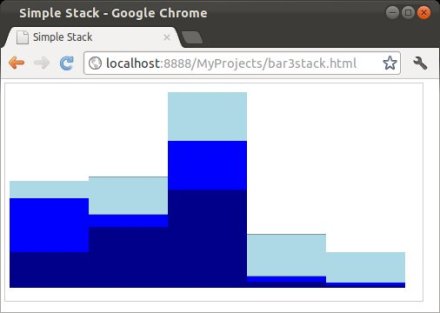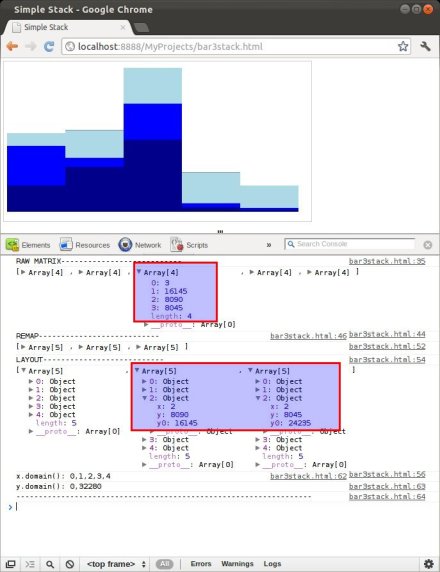In order to understand the physics of various visualizations I walk through the samples and gists I find, dissect them and strip them down to the bare minimum. From there I explore my own variations. I took Mike’s sample for a stacked bar chart and changed it to chart reading from a matrix instead of the csv file.

Stacked Bar Chart
The matrix object
var matrix = [
[ 1, 5871, 8916, 2868],
[ 2, 10048, 2060, 6171],
[ 3, 16145, 8090, 8045],
[ 4, 990, 940, 6907],
[ 5, 450, 430, 5000]
];
The stack layout expects an object with an array of objects, each member of the array represents the values of one value group (eg. “all dark blue values”), and each object contains x and y value. It will process theis array amnd a y0 value (the offset to the baseline).
You can see this if you run the below code with the console.log output.

Console
<!DOCTYPE html>
<html>
<head>
<title>Simple Stack</title>
<script type="text/javascript" src="libnew/d3.v2.min.js"></script>
<style>
svg {
border: solid 1px #ccc;
font: 10px sans-serif;
shape-rendering: crispEdges;
}
</style>
</head>
<body>
<div id="viz"></div>
<script type="text/javascript">
var w = 960,
h = 500
// create canvas
var svg = d3.select("#viz").append("svg:svg")
.attr("class", "chart")
.attr("width", w)
.attr("height", h )
.append("svg:g")
.attr("transform", "translate(10,470)");
x = d3.scale.ordinal().rangeRoundBands([0, w-50])
y = d3.scale.linear().range([0, h-50])
z = d3.scale.ordinal().range(["darkblue", "blue", "lightblue"])
console.log("RAW MATRIX---------------------------");
// 4 columns: ID,c1,c2,c3
var matrix = [
[ 1, 5871, 8916, 2868],
[ 2, 10048, 2060, 6171],
[ 3, 16145, 8090, 8045],
[ 4, 990, 940, 6907],
[ 5, 450, 430, 5000]
];
console.log(matrix)
console.log("REMAP---------------------------");
var remapped =["c1","c2","c3"].map(function(dat,i){
return matrix.map(function(d,ii){
return {x: ii, y: d[i+1] };
})
});
console.log(remapped)
console.log("LAYOUT---------------------------");
var stacked = d3.layout.stack()(remapped)
console.log(stacked)
x.domain(stacked[0].map(function(d) { return d.x; }));
y.domain([0, d3.max(stacked[stacked.length - 1], function(d) { return d.y0 + d.y; })]);
// show the domains of the scales
console.log("x.domain(): " + x.domain())
console.log("y.domain(): " + y.domain())
console.log("------------------------------------------------------------------");
// Add a group for each column.
var valgroup = svg.selectAll("g.valgroup")
.data(stacked)
.enter().append("svg:g")
.attr("class", "valgroup")
.style("fill", function(d, i) { return z(i); })
.style("stroke", function(d, i) { return d3.rgb(z(i)).darker(); });
// Add a rect for each date.
var rect = valgroup.selectAll("rect")
.data(function(d){return d;})
.enter().append("svg:rect")
.attr("x", function(d) { return x(d.x); })
.attr("y", function(d) { return -y(d.y0) - y(d.y); })
.attr("height", function(d) { return y(d.y); })
.attr("width", x.rangeBand());
</script>
</body>
</html>
My gist: bl.ocks.org/2940908


















